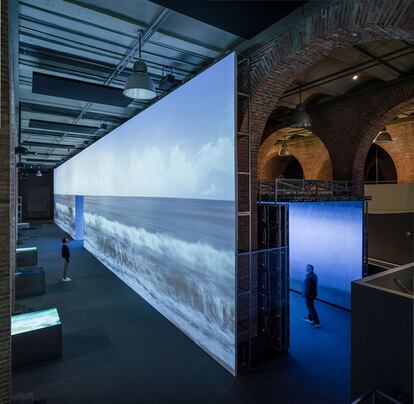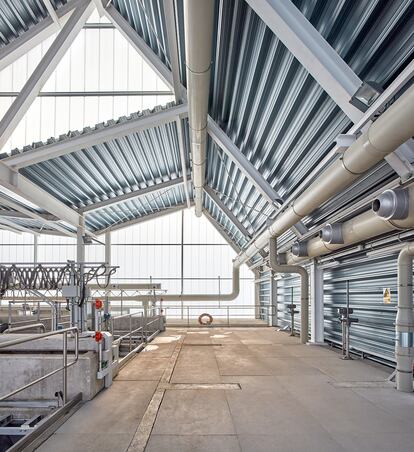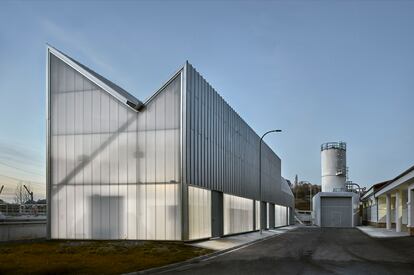Dense cities, rainwater harvesting and porous materials: The architecture that can save us from disastrous droughts
There are already numerous examples of how thoughtful construction can help us fight climate change and adapt to new environmental conditions

Climate change doesn’t only bring along increases in global temperatures, extreme weather and rising sea levels. It also causes drastic changes in rainfall, triggering both floods and droughts. Over the last few months – which were plagued by drought, broken only by a recent storm – Spain has become a glaring example of this environmental tragedy. There’s generally little rain (this past April was the hottest on record)… but when it does rain, it pours.
Uneven rainfall results in both ecological and economic disasters. According to Spain’s Insurance Compensation Consortium and the Geological and Mining Institute, flood damage is estimated to incur a total average annual cost of over $850 million. Hence, it seems as if there’s no alternative: all systems in society – be they political, economic, scientific or industrial – need to accelerate the development of a new model that will allow for an ecological transition towards climate neutrality.
Architecture can also play an important role. Carson Chan – director of the Emilio Ambasz Institute for the Joint Study of the Built and the Natural Environment – notes that architecture is, in fact, “an environmental discipline” that must contribute to the proper management of water. Chan is the curator of Emerging Ecologies: Architecture and the Rise of Environmentalism, an exhibition that will be held at New York’s Museum of Modern Art in the fall. It features a collection of models, photographs, sketches and other archival materials from projects conceived between the 1930s and the 1990s that have strong ecological components.
“We see this exhibition as part one of larger discussions about architecture’s historic, present, and future engagement with the environment,” Chan explains to The Architect’s Newspaper. “It helps establish the historical efforts made by architectural practices to address humanity’s impact on natural systems, [so that we may] look at present and future efforts in an informed way.”
The old art of designing and constructing buildings and cities can be a powerful ally in the fight against droughts and floods at different scales, from the individual level to the national level. Residents, architects, urban planners, municipal managers and politicians can all play a part.
Domestic consumption: beyond daily habits
A 2020 study by Spain’s National Statistics Institute reveals that the average daily water consumption of Spanish households was 133 liters per inhabitant. According to the Ministry for Ecological Transition, most of this water goes towards Spaniards’ shower routines (34%), followed by the toilet (21%), the sink (18%), the washing machine (10%), the dishwasher – which consumes only 5% and saves up to 60% of the water one would use by washing manually – and cooking (3%).
Individual responsibility calls for a conscious review of our daily consumption habits. Controlling shower times, turning off the taps while brushing our teeth or shaving, not using the toilet as a wastebasket and putting full loads in the dishwasher and washing machine can lead to individual savings of between 10 and 25 liters of water per day.
These practices can also be complemented with the implementation of simple, affordable technology in the household. Taps with flow limiters (which can save between 50 and 75% of running water) toilets with dual-flush cisterns, smart irrigation systems and household appliances with low-consumption features (some ecological washing machines save up to 24%; dishwashers, up to 50%) all favor the reduction of water consumption at home, without the need for major renovations.
Anti-drought architecture: new materials and strategies
The global water footprint per capita – which takes into account all daily activities, irrigation, industrial process and transportation – is estimated at 1.24 million liters per year. In some developed countries, however, the figure can be twice as much. Reducing our water footprint depends, in part, on how we eat (the production of a pound of beef requires around 7,000 liters of water, compared to less than 100 liters for a pound of tomatoes) on how we dress (making a cotton T-shirt requires about 2,700 liters of water, compared to 8,000 liters for a pair of jeans) and, crucially, on the architecture that we inhabit.
A pioneering study by the Autonomous University of Madrid has estimated that the construction of a typical residential development (100 homes at 1,000 square feet per unit) in Spain generates a water footprint similar to what would be needed to fill 20 Olympic-sized swimming pools. Meanwhile, researchers from the University of Melbourne have analyzed the water footprint of the most common construction materials. They have found that metals such as copper, aluminum and stainless steel top the list. These materials are followed by wood, which requires double the amount of water than the production of concrete. Finally, earthy materials – such as clays and ceramics – require the least water to produce and transport. As with food, local materials will always have a lower water footprint, since the costs associated with transportation are considerably reduced.

In addition to the materials used, there are other architectural strategies that contribute to saving water. “Although the [type of] use and the number of users are decisive for the design of an appropriate installation, rainwater harvesting systems on roofs are relatively simple to implement in new constructions. With a simple treatment, this water can be used for irrigation and toilets,” explains architect Héctor Navarro, who, alongside colleague Manuel Blanco, is curating an exhibit on water in Madrid. “Other, more complex options may also include the reuse of wastewater (from showers, dishwashers, washing machines) for irrigation and toilets, allowing for multiple cycles of water to be used before it is returned to the sanitation systems.”
In Spain, there are already some buildings that adapt their architecture to the country’s complicated water situation. This is the case with the public transit station at the Felipe VI Park in Logroño, Spain. Designed by Iñaki Ábalos and Renata Sentkiewicz, it was recently awarded the Asprima-Sima 2023 prize, in the category of “Best urban regeneration project.” The station’s roof is a 1,600,000-square-foot park that integrates drainage systems that collect rainwater and irrigation surplus for reuse, in such a way that it hardly consumes water. “This – together with irrigation through the different underground channels that exist in the city – translates into a large area of air purification and an increase in biodiversity, which gives a natural condition to the urban environment,” Ábalos told EL PAÍS in an interview earlier this year.
Urban planning in favor of water: dense, green and porous cities
The challenge for the future is to devise development models and policies that allow us to continue living in cities that consume less and less water. We know that urban density favors the efficient use of energy resources, infrastructures and services necessary for life in a city. Thus, as a general rule, we can conclude that the greater the density, the less water consumption.
Another fundamental strategy involves the “renaturation” of cities. “In a forest, 95% of rainwater is absorbed by the ground and 5% becomes runoff water. However, in urban environments with traditional waterproof pavements, these numbers are reversed. This is the reason why, in scenarios of excessive rainfall, cities end up being flooded,” Navarro explains.

The design of porous cities involves installing soils with natural vegetation, which are adapted to the reality of the environment. Soil is the most permeable option, followed by gravel, sand, or clay. Asphalt and paving stones can also be produced with filtering materials (or hybrid systems, which fill the gaps in the cement with grass or gravel) that serve as both rainwater collection systems and as defenses against torrential downpours and floods. Natural soils also prevent the underground aquifers from drying up, effectively reducing the overheating of urban areas.
Finally, cities must also devote resources to the construction of new water-management infrastructures. “The modern Madrid that developed in the middle of the 19th-century was possible thanks to the creation of the Canal de Isabel II, which brought the necessary water into the city. Today, the canal captures, manages, treats and regenerates the water, which is used to irrigate Madrid’s parks and streets, while returning it to nature in a clean state. We can only understand the cities of the new millennium in this context,” Manuel Blanco emphasizes. He is the director of the Higher Technical School of Architecture of Madrid (ETSAM). “To be able to live in [these cities], we need good, sustainable practices in water distribution, collection, use and purification, [while being able to] return water to its natural environment. Architecture is water, because without it, you cannot build. And, without water, sustainable urban life on our planet isn’t possible,” Blanco concludes.
Historically, expensive water-related facilities – such as water treatment plants, desalination plants, canal systems and treatment plants – have traditionally been perceived as necessary evils. This is why society has generally opted to implement them with strictly functional architecture, sans charisma, to hide them from the public. Today, however, more and more architects are taking the opportunity to turn these vital projects into symbols of development and commitment to the environment. This has been demonstrated by works such as the treatment plant next to Lake Whitney in Hamden, Connecticut. Designed in 2005 by Steven Holl and Chris McVoy, it combines a 360-foot-long stainless steel building in the shape of an inverted drop of water with a five-acre public park near Yale University.


Another good example of this environmental pride is the expansion of the San Claudio water treatment plant, near Oviedo, Spain. Completed in 2016 by the Padilla Nicás architectural firm, it consists of sleek, sharply-defined buildings, in clear harmony with the surrounding structures, all of which are clad in embossed aluminum and translucent polycarbonate, with the intention of reducing their impact on a striking landscape. “Our objective is to provide the new buildings with [sizes and designs] that are respectful of the rural environment in which they are located, satisfying the required uses and heights, while using low-cost and low-maintenance materials,” the creators explain.
Sign up for our weekly newsletter to get more English-language news coverage from EL PAÍS USA Edition
Tu suscripción se está usando en otro dispositivo
¿Quieres añadir otro usuario a tu suscripción?
Si continúas leyendo en este dispositivo, no se podrá leer en el otro.
FlechaTu suscripción se está usando en otro dispositivo y solo puedes acceder a EL PAÍS desde un dispositivo a la vez.
Si quieres compartir tu cuenta, cambia tu suscripción a la modalidad Premium, así podrás añadir otro usuario. Cada uno accederá con su propia cuenta de email, lo que os permitirá personalizar vuestra experiencia en EL PAÍS.
¿Tienes una suscripción de empresa? Accede aquí para contratar más cuentas.
En el caso de no saber quién está usando tu cuenta, te recomendamos cambiar tu contraseña aquí.
Si decides continuar compartiendo tu cuenta, este mensaje se mostrará en tu dispositivo y en el de la otra persona que está usando tu cuenta de forma indefinida, afectando a tu experiencia de lectura. Puedes consultar aquí los términos y condiciones de la suscripción digital.
More information
Últimas noticias
The metaverse, four years later: Is it finished or just at a standstill?
$3,000 and a plane ticket: The United States increases incentives for migrants to self-deport before the end of the year
Charles Dubouloz, mountaineering star, retires at 36 with a farewell tour inspired by Walter Bonatti
From the White House to diplomatic gifts: Lego wins over adult fans, brick by brick
Most viewed
- The low-cost creative revolution: How technology is making art accessible to everyone
- Families demand repatriation of bodies of Colombians who died in Ukraine: ‘This war is a slaughterhouse for foreigners’
- Christian Louboutin: ‘Young people don’t want to be like their parents. And if their parents wear sneakers, they’re going to look for something else’
- All the effects of gentrification in one corner of Mexico’s Colonia Roma
- Christmas loses its festive spirit: ICE fears cast shadow over religious celebrations











































